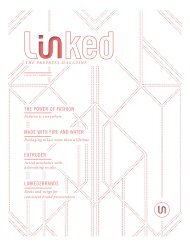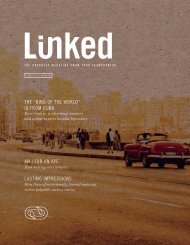Janoschka magazine Linked_V6_2021
You also want an ePaper? Increase the reach of your titles
YUMPU automatically turns print PDFs into web optimized ePapers that Google loves.
28
f a c e t o f a c e
issue #6 ©
l i n k e d
29
Coffee is grown in around eighty, mainly
less developed countries on or close to
the equator. After oil, coffee is the world’s
most important traded commodity and,
after water, its most frequently consumed
beverage. Half of the world’s population
drinks at least one cup of coffee a day.
The planet has roughly 15 billion coffee
trees to cover this demand, and about 100
million people earn their living directly or
indirectly from growing coffee. Around 70
per cent of them are small farmers who
produce their coffee by hand and using a
few simple machines. The pairs of hands
each coffee bean passes through before
it reaches the cup are varied and many –
each just as important as the one before.
Coffee trees grow on slopes, so harvesting
coffee cherries is hard physical work
and requires an attentive and keen eye.
There are two main types of coffee: Arabica
(coffea arabica) or mountain coffee that
grows at an altitude of between 600 and
A world of coffee –
coffee for the world
2 4 °degrees latitude north
coffee belt
2 4 °degrees latitude south
Tropic of Cancer
Tropic of capricorn
Only regions with year-round stable, mild, frost-free climates provide the ideal
conditions for growing coffee and producing top-quality aromatic beans.
Coffee is a classic example of what used to be called “colonial goods” in grocery stores.
While coffee is produced mainly in less developed countries near the equator,
three-quarters of it is drunk in industrialised countries.
2,200 metres; and Robusta (coffea canephora),
which also grows lower down and
is known as lowland coffee.
The coffee cherries are hand-picked and
only the dark-red, ripe berries are harvested.
They grow alongside those that
are still green and those that are only just
blossoming. Once they have been picked,
they need to be processed immediately. A
simple machine is used to extract the two
beans from the cherry. After washing off
any fruit flesh still clinging to the beans,
the farmer then leaves them in a trough to
ferment for at least a day. This method is
known as wet processing. The beans are
then spread out in the sun to dry.
Another method is dry processing. In this
case, the ripe coffee cherries are left intact.
To ensure that they dry evenly, they
are spread out on drying terraces and
turned regularly. Only then does the farmer
crack them open. Whichever method is
used, a kilogramme of cherries produces
only 200 grams of raw beans.
Cherry-picking
with a difference:
What we call “beans”
are actually the seeds
of the coffee cherries.
Many hands –
many eyes
Many coffee farmers are organised in
cooperatives to which they sell their
raw beans. From there, the beans
are taken to the hulling machine that
removes the fine parchment skin.
After that, mechanical shakers sort
the beans according to size. In a final
quality control process, diseased or
discoloured beans – i.e. anything that
might spoil the flavour – are picked
out laboriously by hand. In most coffee-growing
countries, women do
this work, and for many of them it is
the only means of earning an income.
The effort, diligence and care that
goes into producing the world’s coffee
is extraordinary at every step.
Every plantation or cooperative is
rightly proud of its product. This pride
is often reflected in the individual
label printed on the traditional burlap
or jute sacks in which the coffee
makes its long journey to its final destination.
In some places, the sacks
with their colourful labels are just as
much cult items as their contents.
Only after drinking the customary third cup of
coffee does Tesfaye leave the little street café.
There will be many more cups to come. At his
place of work he prepares everything for
today’s round of tasting (or cupping). Cupping
is a universal standardised method for
evaluating and grading coffee.
You might compare it to wine-tasting. For this
ritual, Tesfaye, the coffee sommelier, prepares
a dozen bowls of different types of raw coffee
from Ethiopia’s famous growing areas.
These shimmering silvery green beans don’t
have any flavour yet. Therefore, Tesfaye roasts
four cups’ worth of samples of each variety.
He then places them ready for the four obligatory
infusions. Today’s guests are the owners
of small private roasting outfits from Oslo,
Berlin and Melbourne. After the coffee experts
have assessed the appearance of the green raw
coffees and their appearance after roasting,
they will sniff – and slurp – their way through
countless aromas. Slurping is the only way to
obtain the full taste experience from the coffee.









